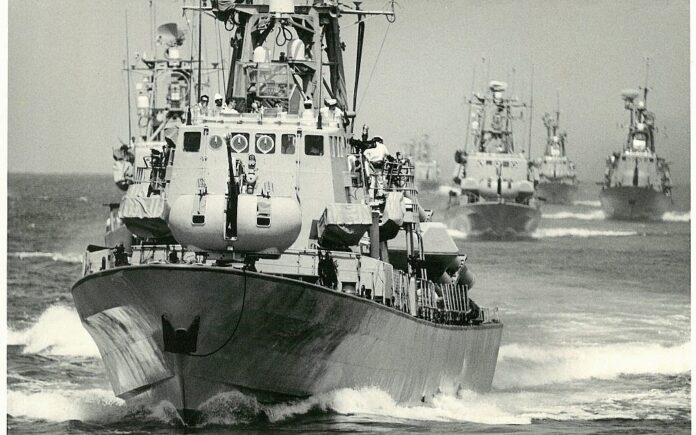Militarily, the naval battles (The Battle of Latakia) of the Yom Kippur War played almost no part in the war’s outcome. However, it initiated a technological and tactical maritime revolution. The Battle of Latakia was a small but revolutionary naval operation of the Yom Kippur War, fought on October 7 1973, between Israel and Syria. It was the first naval battle in history to see combat between surface-to-surface missile-equipped fast patrol boats and the use of electronic warfare (EW) technics, including chaff and electronic jamming. The battles proved the effectiveness of missile and anti-missile systems to control the seas and ushered in the naval operations’ missile and electronic warfare age.
The Procurement of Fast Patrol Boats (FBS)
The Israeli Navy was the only service prepared to fight and win the war from its initiation. While 1967 was an overwhelming victory for the army and air force, the Navy found itself outgunned by Egypt’s Soviet-built missile boats. Egypt sank the Israeli destroyer Eilat with anti-ship missiles from its small, manoeuvrable, and heavily armed missile boats. Israel’s Navy traditionally had an inferior status domestically compared to the other military services, and the deaths of 47 sailors on the Eilat reinforced that public opinion (Adam B. Green, “The Israeli Navy’s Application of Operational Art in the Yom Kippur War: A Study in Operational Design”, Naval War College, May 12, 2017)
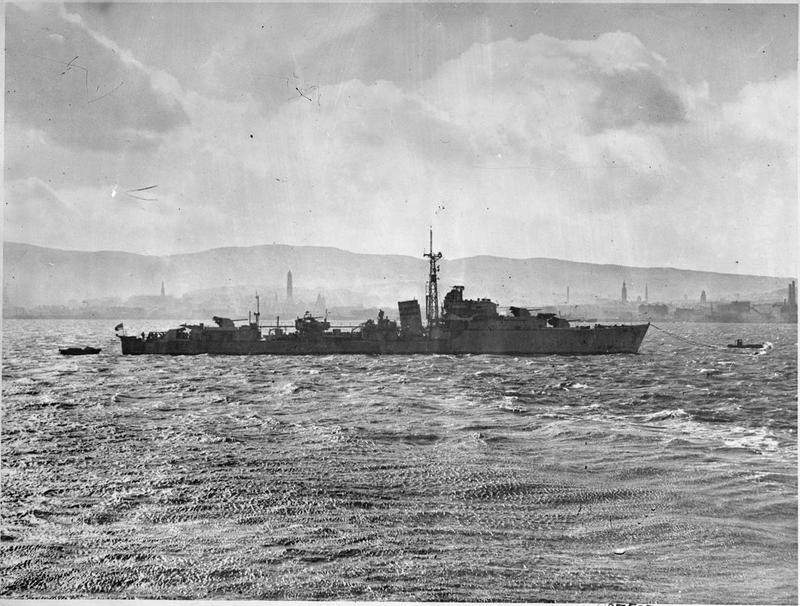
The Israeli Navy noticed the India-Pakistan conflict and decided to have guided missile FBS to its inventory. Small boats with advanced missiles had a more significant advantage over large ships like destroyers and frigates in the Eastern Mediterranean and the Red Sea littoral waters.
At the beginning of the Yom Kippur War, the Israeli Navy consisted of fourteen Sa’ar-class missile boats. Syria’s Navy consisted of three Osa– and six older Komar-class missile boats, eleven torpedo boats, and two minesweepers.
How Israel Navy Eluded the guided-missile range shortfall?
The Styx missiles of Syria and Egypt also had 25 nautical miles range compared to the 12 nautical mile range of Israel’s Gabriel missiles. Despite Israel’s new ships, training, and preparations, its Navy was still “out-ranged in missiles and outnumbered more than two to one”. As a counter precaution, Israel accelerated its development of advanced electronic countermeasures to provide a greater defensive buffer for its new fleet. Israeli naval leaders also war-gamed and experimented with new tactics to add additional defensive capabilities to their ships.
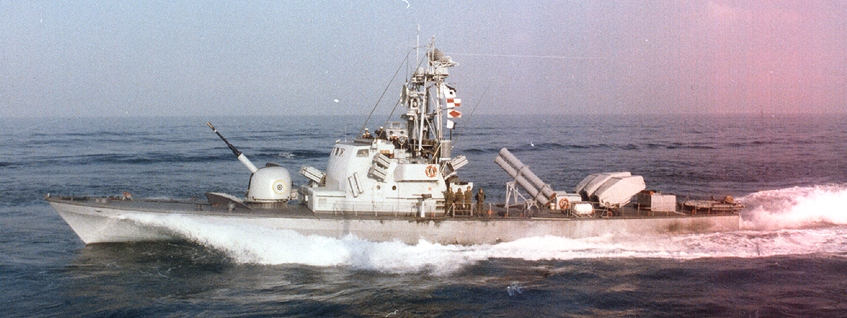
Latakia Naval Operation
The Latakia Naval Operation took place on the night of October 6, 1973, the first day of the Yom Kippur War involving small ships. The naval engagement takes its name from one of Syria’s naval bases on the Mediterranean Sea.
The Egyptian and Syrian attack against Israel on October 6, 1973, caught Israeli forces by surprise. Israeli Navy missile boats put to sea that very evening to carry out a long-planned attack against units of the Syrian Navy. It would be the first combat test for the missile boats, on which the Israeli Navy had expended much energy over the previous decade. The Israeli Gabriel anti-ship missile used a joystick tracking system requiring that the operator keep it on target by radar. It had never been fired in actual combat.
Meanwhile, the Soviet SS-N-2 Styx fire-and-forget (meaning that it does not require human tracing once fired) missile employed by the Syrians was combat-proven. However, Israeli developed electronic countermeasures (ECM) to defeat the Styx had never been tested in combat.
The Navy aimed to remove the possibility of a Syrian naval attack on the Israeli Mediterranean coast. Within the scope of the Latakia operation, The Israeli plan was to lure the Syrian missile boats out and engage them at the maximum range of their Styx missiles, which the Israelis hoped to defeat through the chaff and electronic countermeasures (ECM).
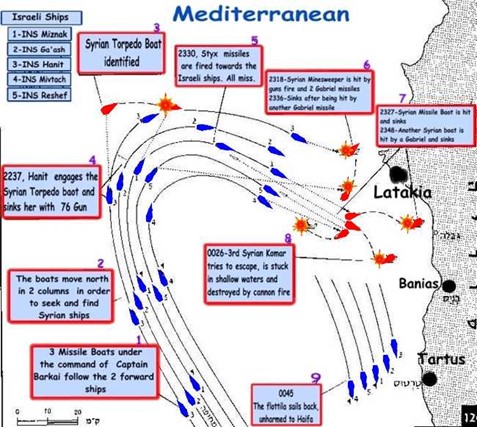
The Israeli naval flotilla consisted of five missile boats (the Saar-class Gaash, Hanit, and Miznak and the Reshef-class Miv tach and Reshef ) committed to the operation in the Battle of Latakia. The Latakia plan was to proceed wide to the west toward Cyprus to avoid Syrian coastal radar and attack from the north, the direction the Syrians would least expect. The boats moved in two parallel columns: Barkai’s own Miznak (flagship), Gaash, and Hanit to port and the Mivtach and Reshef to starboard and slightly behind, several miles closer to shore.
At 23:30 hours, three targets appeared on the Israeli radar screens: three Syrian missile boats, one Osa and two Komars. The Syrian ships were armed with P-15 Termit (NATO SS-N-2 Styx) missiles, a weapon used against the Israeli destroyer Eilat by the Egyptians six years earlier. The Styx had twice the range of the Israeli Gabriel and a much larger warhead.
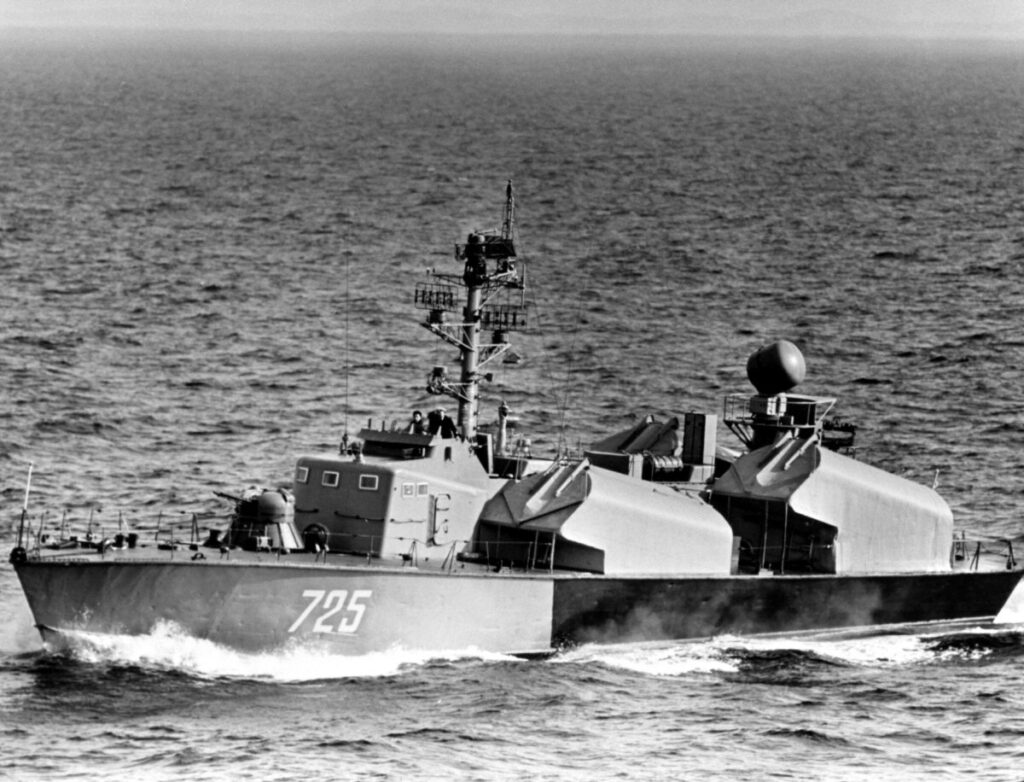
The Syrians fired missiles at 45 kilometres, 25 kilometres beyond the range of the Israeli Gabriel missiles. As the Styx missiles drew closer, the Israelis employed a series of electronic countermeasures that had never been used in combat. They fired chaff rockets, which produced clouds of aluminium chaff that presented false images to the Styx radar. Electronic jamming systems sent out false radar signals to confuse the guidance systems on the approaching missiles. All missiles fired by the Syrians missed their targets and crashed into the sea.
The Israeli boats attacked at full speed. Once in range, they fired a salvo of Gabriel missiles. All three Syrian boats were hit, two sunk immediately. The third ship tried to escape towards the coast and ran aground in shallow waters. The Israeli boats attacked with cannon fire, leaving the Komar in flames.
Following the Battle of Latakia, the Syrian Navy remained in port for the rest of the war. The battle also brought new prestige to the Israeli Navy, previously regarded by most observers as only a poor relation of Israel’s highly regarded army and air force. Israeli ECM techniques employed in the battle set a new standard for subsequent naval engagements using missiles.
Conclusion
Israeli achievements in offensive and defensive missile technology marked the beginning of the missile age for naval warfare, especially for coastal combat power. The size of the ship and its guns mattered far less than its missiles and their accuracy. Defensive countermeasures like chaff, electronic jamming, and radar-absorbent paint became necessities as ships now acted under the premise of first-to-see, first-to-kill. Such offensive and defensive measures are mandatory in today’s naval operating spaces where anti-access/area-denial strategies and over-the-horizon systems are prolific, especially concerning the littorals and close operational areas of the Pacific and Middle Eastern theatres.


